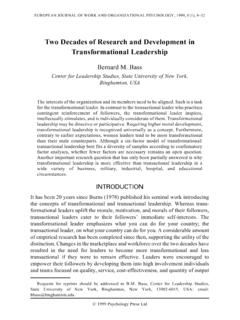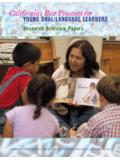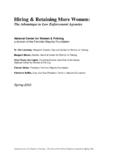Transcription of THE POWER OF PLAY - childrensmuseums.org
1 THE POWER OFPLAYA research Summary onPlay and LearningDr. Rachel E. White for2Dr. Rachel White earned her doctorate in Child Psychology at the Institute of Child Development, University of Minnesota. Dr. White s research focuses on how children can benefit from play and imagination in early childhood. She has also studied youngchildren's creation of imaginary companions, and how pretending relates to early social understanding, cognitive development, and school readiness in diverse populations of preschool-aged children. research for this paper was collected in fall OF CONTENTSL etter from the President ..3 Introduction ..5 What is play ? ..6 The play Continuum.
2 6 The Role of Free and Guided play ..7 play and Development ..8 Social play ..9 Social play with Adults ..9 Social play with Peers ..10 Object play ..11 Exploratory play ..11 Object play ..11 Cognitive Benefits ..12 Conceptual Knowledge through Exploration ..12 Problem-solving and Creativity ..12 Convergent and Divergent Problem Solving ..12 Science, Technology, Engineering, and Math ..14 Pretend play ..15 The Timeliness for Pretense ..15 The Benefits of Pretend play ..15 Cognitive Benefits ..16 Creativity ..16 Language and Literacy ..16 Executive Function ..18 Social and Emotional Benefits ..20 Navigating Interpersonal Interactions.
3 20 Socialization ..20 Social Understanding ..21 Coping and Emotion Regulation ..22 Benefits of the Whole Child ..23 Physical play ..24 Benefits of Physical play ..24 Physical Benefits ..24 Cognitive/Academic Benefits ..25 Media play ..25 Cognitive/Academic Benefits ..26 Facilitating play ..28 Roles ..29 Facilitation Techniques ..30 Conclusion ..31 Bibliography ..32 With a mission to spark children s learning through play , Minnesota Children s Museum provides hands-on learningexperiences to more than 400,000 visitors each year in Minnesota, as well as millions of children around the countrythrough the leading traveling exhibit program for children s museum.
4 While recognizing that children learn in many ways,the Museum focuses on the learning that occurs through child-centered may seem simple, yet it is profound to a child s development. play makes learning something that happens naturallyand joyfully, when a child laughs and wonders, explores and imagines. For more than 30 years, Minnesota Children s Museum has embedded research on play and child development into inter-active learning environments through its exhibits and programs. As the Museum embarks on an ambitious expansion, weare presented with a pivotal opportunity to strengthen our connection to child development and high-quality research onthe role of play in early learning.
5 The following research summary is a unique and robust compilation of published research on the major types of play foryoung children and related learning benefits. We are deeply grateful for the dedication of Dr. Rachel White in amassing,synthesizing and digesting the breadth of research that has been conducted in this field. A special thank you to the University of Minnesota s College Readiness Consortium, under the leadership of Kent Pekel,for making Dr. White s work possible through persistence and funding grounded in the belief that college readiness beginsin early childhood. We also thank the numerous researchers and experts who reviewed and advised on the summary,including Dr.
6 Stephanie Carlson, Dr. Megan Gunnar, Dr. Sara Langworthy, Barb Murphy, Dr. Amy Susman-Stillman, and Julie Sweitzer. An additional thank you to Dr. Gunnar, University of Minnesota Regents Professor and Director of the Institute of Child Development, for chairing the Museum s research Advisory Council that continues the researchpartnership started with this Children s Museum s staff is eager to apply this research , building on our strengths of engaging children inlearning experiences and extending the insights to parents and all the caring adults in a child s life. We hope you find thisresearch as inspiring as we do. Playful learning is fun and it s powerful.
7 Please join us in fostering the undeniable, incredible, exceptional POWER of play ,wherever the setting. Dianne KrizanPresidentMinnesota Children s MuseumPLAY IS SIMPLE, YET ALSO PROFOUND34In play it is as though [the child] were a headtaller than himself. As in the focus of a magnifyingglass, play contains all developmentaltendencies in a condensed form and is itself amajor source of development. Lev VygotskyINTRODUCTIONV irtually every child, the world over, plays. The drive toplay is so intense that children will do so when they haveno real toys, when parents do not actively encourage thebehavior, and even in the middle of a war zone. In the eyesof a young child, running, pretending, and building are and educators know that these playful activitiesbenefit the development of the whole child across social,cognitive, physical, and emotional domains.
8 Indeed, play issuch an instrumental component to healthy child devel-opment that the American Academy of Pediatrics (Ginsburg,2007) issued a white paper on the topic, the National Associ-ation for the Education of Young Children (2009) namedplay as a central component in developmentally appropriateeducational practices, and the United Nations HighCommission on Human Rights (1989) recognized play as afundamental right of every , while experts continue to expound a powerfulargument for the importance of play in children s lives, theactual time children spend playing continues to , children play eight hours less each week than theircounterparts did two decades ago (Elkind, 2008).
9 Underpressure of rising academic standards, play is beingreplaced by test preparation in kindergartens and gradeschools, and parents who aim to give their preschoolers aleg up are led to believe that flashcards and educational toys are the path to success. Our society has created afalse dichotomy between play and paper presents an overview of the scientific researchthat guides the educational philosophy that play is learning,discussing many overlapping forms of child-centered play ,including social, object, pretend, physical, and media play , children learn to regulate their behavior, laythe foundations for later learning in science and mathe-matics, figure out the complex negotiations of socialrelationships, build a repertoire of creative problem solvingskills, and so much more.
10 Finally, this paper also addressesthe important role for adults in guiding children throughplayful learning experts continue toexpound a powerful argument forPLAY, the actual time childrenspend playing continues todecrease. Despite the fact that adults can intuitively identify play (Smith & Vollstedt, 1985), full consensus on a formaldefinition continues to elude the researchers and theoristswho study it. Definitions range from discrete descriptions ofvarious types of play such as physical play , construction play ,language play , or symbolic play (Miller & Almon, 2009),to lists of broad criteria, based on observations and attitudes,that are meant to capture the essence of all play behaviors(Burghardt, 2011; Rubin, Fein, & Vandenberg, 1983).






